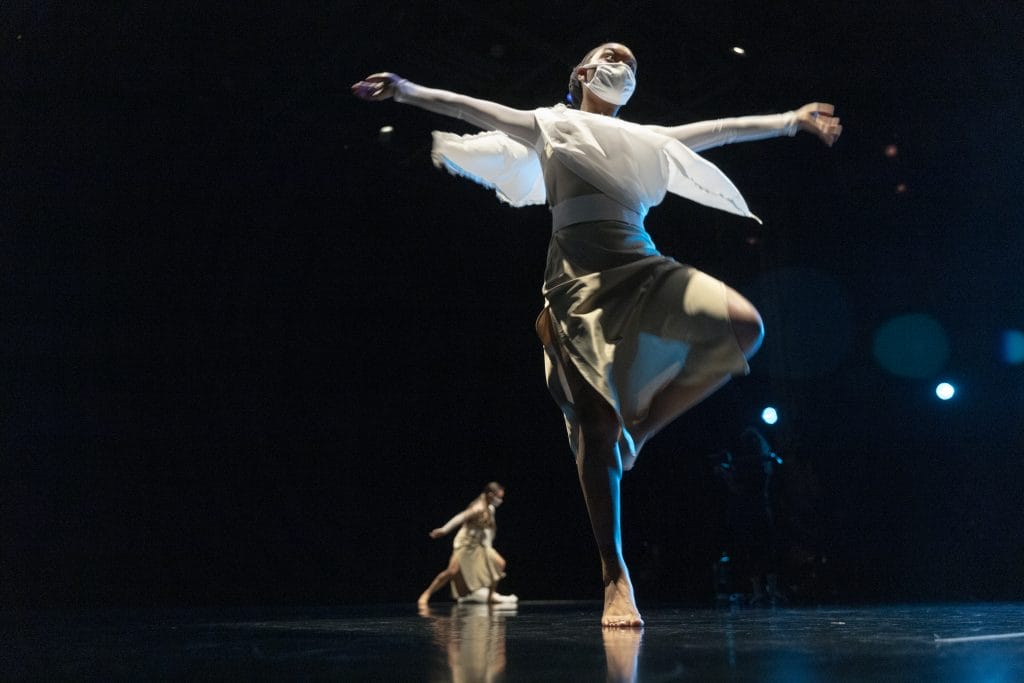‘Feeling Distance’: VCUarts students explore isolation through interactive dance routine

The VCUarts dance department showcased its last performance of the Dance Now series on Friday, featuring VCUarts dance students N’dea Harris (front) and Marissa Schroeder (back). Its central theme was isolation during the pandemic. Photo by Enza Marcy
Claire Darcy, Contributing Writer
Kate Sicchio, assistant professor of dance and media technologies, said she is thankful her toddler still gives her hugs.
“I’m lucky that I have my family and I’m really lucky that I have a toddler because they just want to touch all the time,” Sicchio said, “but I miss hugging friends a lot.”
Inspired by this void, Sicchio created an interactive dance routine, titled “Feeling Distance,” which was the fourth and final installment of VCUarts Dance Now 2021. The delicate and intimate performance took place Friday on a website designed for the event.
Performances in the Dance Now series had themes such as COVID-19, isolation and mental health. The annual dance showcase event typically takes place in person over one weekend. This year, however, it was hosted virtually across four weekends.
Freshman Marissa Schroeder and senior N’dea Harris performed in the series, wearing costumes that responded to electronic signals sent by viewers to simulate a physical connection between audience and dancers in a time of social distancing.
Having previously worked with wearable technology, Sicchio said she wanted to create a virtual performance that went beyond video streaming.
“The internet is so much more than that,” Sicchio said. “There’s all sorts of ways we communicate. We can do it in real time.”

Sicchio and her team of two student researchers, juniors Tamara Denson and Taylor Colimore, worked to create costumes that would respond when audience members pressed a certain button on the streaming website. The “linger” button caused the costume to inflate, while the “release” button made the costume deflate.
The dance and its costumes represented themes of isolation and the lack of shared physical touch during the COVID-19 pandemic.
“I miss touching people; I miss hugs,” Sicchio said. “That was actually one of the early things we talked about with making the garment was ‘how would you send a hug? Can we make it feel like a hug?’”
When inflated, the costumes simulate the lingering feeling of a physical touch, Sicchio said.
Denson, a dance major, helped to create the costumes by soldering all the electronic components and working with Sicchio to set up the livestream website and its audience interaction features.
The interactive costume pieces consist of two asymmetric, white triangular pieces of nylon fabric attached to the body by a white belt.
“We created this sense of feeling,” Denson said. “We can’t touch other dancers but we have something to touch and hold onto.”
An electronic board and a fan blower inside the belt inflates and deflates the costume’s fabric after receiving a signal. The signals connect to a German satellite between leaving audience computers and pinging the costumes, Denson said.
“What’s happening behind the scenes is that the button pressing is going through a server which is sending that information back to my computer, which is networked to the costumes,” Sicchio said. “All of this happens with almost no latency. It’s super responsive.”
Colimore, a kinetic imaging major, helped configure the livestream connection and settings, and operated the camera during the performance. She also contributed to the early stages of the costume design process.

Sicchio and Colimore said the camera was an unseen performer that roamed the stage to track the movements of the performers for the livestream audience.
“Usually in dance performances, you get to see the entire stage, and you only get to see it from one angle,” Colimore said. “The point of view gets to be on the stage and constantly changing so you get to see the movement from a completely new perspective.”
Colimore captured close images of the dancers while keeping a safe distance by utilizing a close-frame zoom feature on the camera, she said.
Schroeder and Harris wore masks while performing and danced in designated sections of the stage to maintain social distancing.
The choreography had two components: an improvised response to the changing costume based on its simulated “touch” and a set performance score. Although they could not dance with each other in close proximity, Sicchio said the dancers were able to communicate using call-and-response choreography and the movement of the costumes.
“It tries to emulate the feeling of dancing with others without actually being able to,” Colimore said. “It’s definitely a pandemic piece.”



